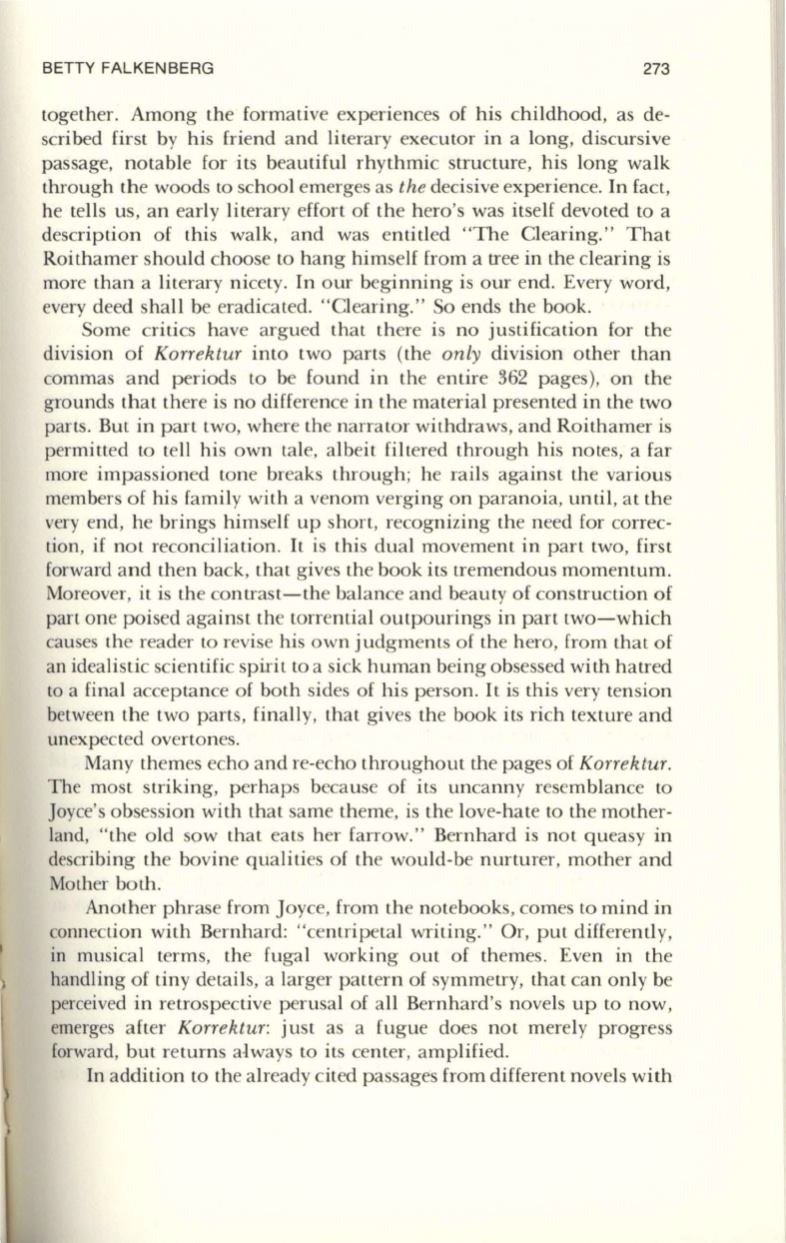
BETTY FALKENBERG
273
together. Among the formative experiences of his childhood, as de–
scribed first by his friend and literary executor in a long, discursive
passage, notable for its beautiful rhythmic structure, his long walk
through the woods to school emerges as
the
decisive experience. In fact,
he tells us, an early literary effort of the hero's was itself devoted
to
a
description of this walk, and was entitled "The Clearing." That
Roithamer should choose
to
hang himself from a tree in the clearing is
more than a literary nicety. In our beginning is our end. Every word,
every deed shall be eradicated. "Clearing." So ends the book.
Some critics have argued that there is no justification for the
division of
Korrektur
into two parts (the
only
division other than
commas and periods to be found in the entire 362 pages), on the
grounds that there is no difference in the material presented in the two
parts. But in part two, where the narrator withdraws, and Roithamer is
permitted to tell his own tale, albeit filtered through his notes, a far
more impassioned tone breaks through; he rails against the various
members of his family with a venom verging on paranoia, until, at the
very end, he brings himself up short, recognizing the need for correc–
tion, if not reconciliation.
It
is this dual movement in part two, first
forward and then back, that gives the book its tremendous momentum.
Moreover, it is the contrast-the balance and beauty of construction of
part one poised against the torrential outpourings in part two-which
causes the reader
to
revise his own judgments of the hero, from that of
an idealistic scientific spirit to a sick human being obsessed with hatred
to a final acceptance of both sides of his person.
It
is this very tension
between the two parts, finally, that gives the book its rich texture and
unexpected overtones.
Many themes echo and re-echo throughout the pages of
Korrektur.
The most striking, perhaps because of its uncanny resemblance to
Joyce's obsession with that same theme, is the love-hate to the mother–
land, "the old sow that eats her farrow." Bernhard is not queasy in
describing the bovine qualities of the would-be nurturer, mother and
Mother both.
Another phrase from Joyce, from the notebooks, comes to mind in
connection with Bernhard: "centripetal writing." Or, put differently,
in musical terms, the fugal working out of themes. Even in the
handling of tiny details, a larger pattern of symmetry, that can only be
perceived in retrospective perusal of all Bernhard's novels up to now,
emerges after
Korrektur:
just as a fugue does not merely progress
forward, but returns a·lways to its center, amplified.
In addition to the already cited passages from different novels with


